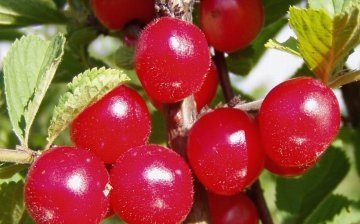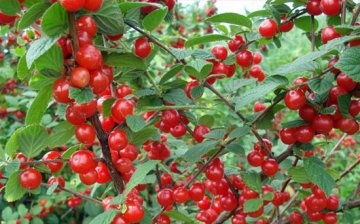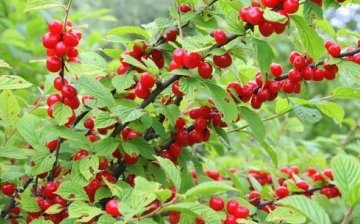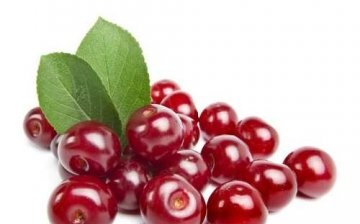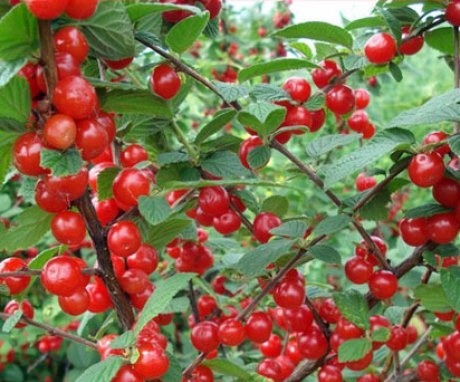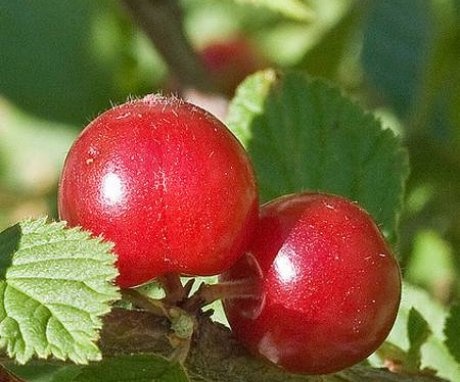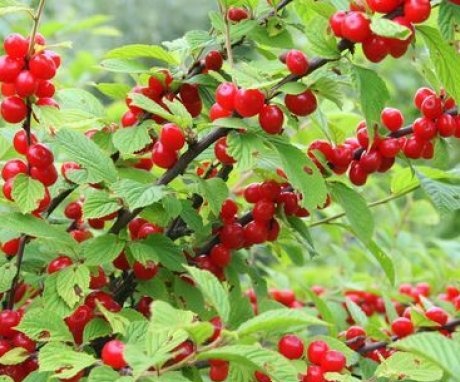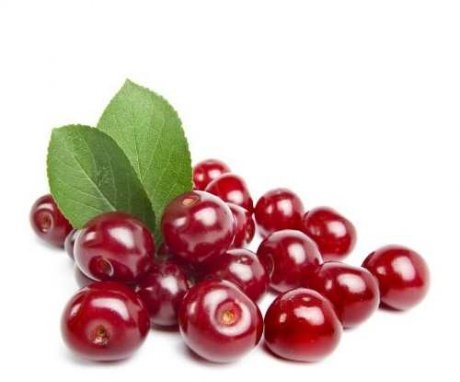Felt cherry: varieties, care features and breeding methods
The cherry got its name because of the pubescence that is present on fruits, leaves and shoots. Felt cherry can grow as a short shrub, or as a tree, plant height ranges from 1 to 3 meters. The crown is oval, the branches are massive, brown.
Content:
- The difference between felt cherry and ordinary
- Variety of varieties
- Growing and care
- Reproduction of felt cherries
The difference between felt cherry and ordinary
When people in the Far East talk about cherries, they certainly talk about felt cherries. It was first brought to the European part of the continent by Ivan Michurin, thanks to him a form with large fruits was developed. The young plant has green branches, the buds on them are collected in groups of 3 pieces. The life of fruit formations is up to 4 years.
Cherry leaves are small, the surface is corrugated. At the beginning of flowering, the flowers have a pink tint, by the end of the flowering period they turn white. Flowers and leaves bloom at the same time, at the end of May. Flowering lasts about 2 weeks.
The abundant flowering attracts large numbers of bees.
Felt cherry is more compatible with plums than with common cherry... Most often it is crossed with plum, peach, apricot or cherry plum.
The main differences between felt cherry and ordinary cherry:
- Early fruiting.
- Resistant to frost.
- Decorativeness.
- Stable harvest.
An important feature of the felt cherry is its resistance to coccomycosis. This disease loves common cherries, and sometimes affects 80% of its harvest. The lifespan of a felt cherry is no more than 10 years. To increase this figure, gardeners use anti-aging pruning.
The fruits do not crumble, and due to the low growth of the plant, the berries are easy to pick. Fruit ripening occurs a week or two earlier than that of an ordinary one.
Felt cherry fruits are very useful:
- They contain a large amount of vitamins B, C and PP, carbohydrates and organic acids.
- The iron content is several times higher than in apples.
- The fruits contain biologically active polyphenols that strengthen the capillaries.
- Felt cherry fruits increase appetite, have a positive effect on the digestive tract.
- In cooking, they are used to make jams, jams, marmalades, juices and compotes.
From one bush, you can collect from 5 to 14 kg of the crop, it depends on climatic conditions and agricultural technology. If all the rules of cultivation and care were followed, then it is possible to collect up to 20 kg of cherries.
Variety of varieties
Felt cherry varieties are divided into groups depending on the period of flowering and ripening of fruits, they are divided into:
- Early.
- Mid-season.
- Late ripening.
So, early varieties:
- The first is Natalie. It is a shrub of medium density, the crown is wide, the flowers are large, pink in color. The fruits grow up to 5 grams in weight, the pulp is dense. An adult plant is capable of producing up to 7 kg of harvest. In the room, the fruits are stored for 3 days, in the refrigerator for a week.
- The princess is a short bush with bright pink fruits, the fruits are large, ovoid, the taste is sweet and sour. One bush gives a maximum of 9 kg of yield. Cherries of this variety live for 17 years.
- Children's. The bush is not very thickened. The fruits are scarlet with dense pulp, the weight of each fruit is up to 4 grams, the harvest weight is up to 15 kg, the taste of cherries is sweet and sour.
- Story.A bush of medium thickening, burgundy fruits, each weighing up to 4 grams, from one bush you can harvest up to 10 kg.
- Fabulous. The bush is widely branched, the fruits are burgundy, the weight of each is no more than 4 grams, the taste is sweet and sour. One bush gives a yield of about 12 kg.
- Yielding. Branches branch widely fruits are dark pink, small, sweet and sour, the weight of the crop from one bush is not more than 12 kg.
The following varieties are mid-season:
- The dark-haired oriental. Low, but broadly branched bush, burgundy fruits, small, sweet and sour taste. Productivity due to the small size of the bush is also low, up to 7 kg.
- Anniversary cherry. Large, branched bush, red, medium-sized fruits with juicy pulp. The harvest gives no more than 9 kg.
- The fire has large fruits of light red color. The berries taste sweet and sour, juicy.
- White. A medium-sized bush with small fruits, the pulp is juicy, sweet and sour, white. Outside, the berry is also white.
- Alice is a bush of medium height with a dense crown, burgundy fruits, medium-sized fruits. The pulp is sweet and sour, the taste is soft.
Are two more varieties late?
- Ocean virov cherry. The bush is large, but not highly branched. Fruits are medium in size, with dense pulp, sweet and sour taste, burgundy in color. From one bush, you can collect berries up to 10 kg.
- Damanka is a new variety of felt cherry. Its fruits are large, burgundy in color. The fruits of this variety have the best taste, although the yield is not very high, no more than 10 kg.
When choosing a variety for cultivation, you need to focus on the conditions of the region.
Some varieties are regionalized for a specific area. This is the only way to achieve maximum yield.
Growing and caring
Felt cherries are not sold either in markets or in supermarkets; this is due to the fact that they are difficult to transport and cannot be stored for a long time. The life of the tree itself is short, and in order for it to bear fruit, several different varieties must be planted nearby, since the felt cherry is self-fertile.
It is best to plant felt cherries in early spring, before the buds have time to bloom.
The deadline for planting is September. If the seedlings were purchased after this period, then it is better to dig them in and leave them until spring. The soil for cherries is loamy or sandy. Peat bogs and too wet soils are categorically unsuitable. A place on the site is chosen sunny, elevated, at this place there should not be stagnant water or closely located groundwater.
Growing features:
- Felt Cherry loves fertilizer... Organic fertilizers are applied immediately after flowering in the amount of 5-7 kg, a little potassium, nitrogen and phosphorus fertilizers are added.
- Every year it is necessary to thin out the center of the crown; no more than 12 of the strongest shoots should remain on the tree.
- Already in the third year, the cherry gives its first fruits and then begins to actively bear fruit. Depending on the variety, the tree gives a different amount of harvest at different times.
- If the berries will be transported to another place, then it is better not to wait until they are finally ripe on the tree, but to collect them in advance.
- When planting, the bush must be placed in such a way that the root collar is 4 cm above the soil level. When the soil subsides a little, the root collar will take place on a level with the surface.
At the end of winter, the trunk circle will need to be mulched with peat, loose earth or humus, in the spring the mulch is removed.
To protect the cherry from pests, the bushes are sprayed with Bordeaux liquid or copper oxychloride solution before flowering. The procedure can be repeated after flowering.
In general, the care is similar to that of an ordinary cherry, the soil is weeded and loosened in the near-stem circle, watered and fertilized.
Reproduction of felt cherries
To propagate felted cherries, seed sowing is used:
- This method is only suitable for species, not varieties. Fruit seeds are well cleaned, washed and dried in the shade.
- In August, they are placed in wet sand and left in a cool room until October.
- Then they are transferred to the garden bed and placed in 3-centimeter grooves.
The first shoots will appear in the spring, if you create the right conditions, then in the first year they will grow up to 50 cm. Next year or this fall, young cherries can be planted in a permanent place.
Often, seedlings appear under the felt cherry bush, which have grown from the seeds of fallen berries.
The soil for sowing seeds should be rich in organic matter. Humus or compost, superphosphate and potassium chloride are added to it. The seeds are sown in rows, then the soil is mulched with peat or humus.
Fertilizing cherries:
- The first feeding is done when more than 5 leaves have formed on the plant, ammonium nitrate and double superphosphate are added.
- The second feeding is done when more than 10 leaves are formed, for this you will need urea, potassium sulfate and superphosphate. If the sprout is weak, then it is grown for another year.
Seed propagation not suitable if the cherry has been selected, with large fruits, frost-resistant. In this case, all these qualities may disappear.
To preserve all valuable qualities, it is advisable to use a vegetative reproduction method. For this, woody or green cuttings are suitable.
For reproduction, cuttings of the current year, or of the second and third branching, but not less than 15 cm long, are taken. Part of last year's wood should be 2 cm. Cuttings are treated with a growth regulator for 12 hours and planted in a ready-made substrate.
After that, the substrate is covered with polyethylene, the edges of the film are pressed tightly to the ground.
You can use cheesecloth to shade the stalk, or on hot days, a double layer of gauze. Moisture will circulate and thus the stalk will be moistened. If the weather is dry, then the soil can be watered. When the buds sprout, the cuttings can be removed.
Growing felt cherries will take a little wait, but the time and effort are worth it. This is not only delicious berries on the table, but also the decoration of the entire garden.
More information can be found in the video.



